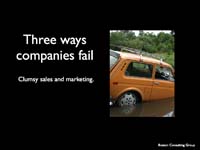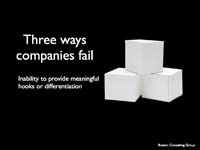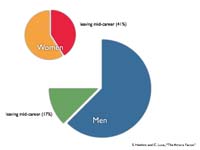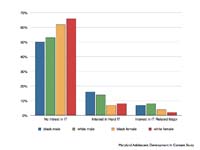These are notes from my presentation at the Hawaii International Conference on System Sciences (HICSS) #45 on Agile values, product innovation and the shortage of women software developers.
I’ve broken the fifty slide, eighteen minute presentation into several posts.
This first part uses existing research to establish:
- women are under-represented in software development,
- this is a multi-decade trend atypical of Science, Technology, Engineering and Math (STEM),
- women are leaving mid-career in disproportionate numbers and
- young women are opting out as early as middle and high school.
I’ll link to my full paper when it is available and to subsequent posts as I publish them.
There is an abundance of research on the problems women face in our field. I would love real researchers to jump in on whether Agile principles and Agile practioners can really make a difference here.
I’d also love any suggestions of organizations, institutions and individuals I might reach out to for more information, collaboration, or to take up the cause.

(1-2) Hello,
My premise is the lack of women developers in the US is an impediment to value delivery and product innovation in the software industry.
In light of this, Agile principles call on practitioners to confront hostile workplace conditions and enterprises to address the material impediments of pay and advancement.
This beneficial change in teams and companies can incrementally change perceptions in the larger society.

(3) To introduce myself
I’m a software practitioner not a consultant or educator. I’ve studied and applied Agile methods for nine years.
I’ve spent most of my career in woman run organizations.

(4) I have a daughter
…who loves technology and sought out a culturally diverse, math and science school in Brooklyn. So, this topic is personal to me.

C. Hayes. “The Incredible Shrinking Woman” in Gender Codes : Why Women Are Leaving Computing. T. Misa, Ed. Hoboken, N.J. IEEE Computer Society, 2010, pg. 33
(5) Women are underrepresented in Computer Science
According to the US Bureau of Labor Statistics, women represent 46% of the workforce but only 25% of software developers. Over two decades the percentage of women developers has steadily declined.

S. Hewlett and C. Luce,. “The Athena Factor.” Harvard Business Review, pp. 51, Jun. 2008.
(6) Women are leaving mid-career
Women are leaving IT in larger numbers than men. 56% of women leave mid-career across all technology occupations. 41% leave their careers in “high technology” compared to only 17% of men. Half of women leaving STEM careers leave the STEM sector completely.

Four Decades of STEM Degrees, 1966-2004: ‘The Devil is in the Details.’” CPST, Sep. 2006, pg. 3.
(7) Women are not studying Computer Science
According to the Commission on Professionals in Science and Technology, in the decade between 1986 and 1995 the number of women earning Computer Science bachelor’s degrees dropped 55%. As of 2010, the percentage was still falling despite growing percentages of women graduating from four year colleges. This is not typical of STEM where 49% of bachelor degrees go to women.

N. Zarrett and O. Malanchuk. “Examining the Gender Gap in IT by Race” in Women and IT. J. Chohoon and W. Aspray Ed. Cambridge, MA. The MIT Press, 2006, pp.55-88.
(8) Young Women are disinterested in pursuing high tech education or careers
The Maryland Adolescent Development in Context Study, a longitudinal study of 1,400 white and african american students found that women were much more likely to have no interested in IT related careers and degrees than men.

(9) At what cost to the software industry?
In the last decade, the U.S. software industry represented $200B in annual sales and employed 2.2M software professionals. McKinsey & Co estimates in this decade, demand for mid-career IT professionals will increase by 25% while the available pool will decrease by 15%. This in a country where 71% of workers are in jobs with low demand or an oversupply of eligible candidates.

(10) The cost of attrition
And let’s also get at the cost of attrition. According to HR magazine, it costs approximately 100-125% of an employee’s annual salary to replace them. Retaining one-quarter of the women who leave computer engineering mid-career could represent a ten year savings of $8B to the industry.
Next: Are women are under-served by software…
The full citation list for my paper.




















